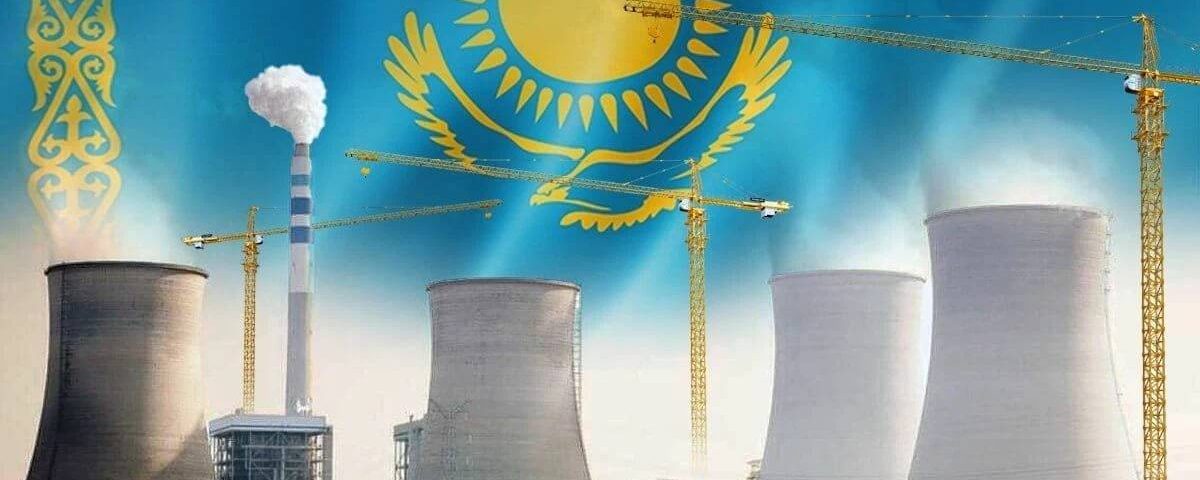Nuclear power plants (NPPs) are among the most important sources of electricity in the modern world, playing a crucial role in energy security and economic growth. These facilities are capable of generating large volumes of electricity with minimal carbon dioxide emissions, making them key contributors to both energy production and climate goals. Despite the rise of alternative energy sources like solar and wind power, nuclear energy remains a central component in the energy strategies of many countries (IAEA.org, 2016).
Energy independence is a vital strategic objective for any country, and Kazakhstan is no exception. With global hydrocarbon market volatility and the country’s reliance on imported fuel, Kazakhstan must seek sustainable solutions to secure its energy future. Nuclear energy provides the opportunity to establish a stable and reliable energy supply system that is not dependent on external sources of fuel or global fluctuations in oil and gas prices. According to the International Atomic Energy Agency (IAEA), NPPs can offer long-term, stable electricity generation with minimal fuel costs (IAEA.org, 2021), thereby strengthening Kazakhstan’s energy security.
Kazakhstan faces regular electricity shortages due to growing demand, driven by industrialization, population expansion, and the inefficiency of its current power plants. The country also inherits outdated nuclear infrastructure from the Soviet era, which no longer meets modern energy needs. These challenges are compounded by inadequate investment in maintaining and modernizing the energy sector. For instance, in 2024, electricity consumption increased to 120 billion kWh, while production rose to 117,9 billion kWh. The peak consumption during the autumn-winter period reached 17,2 GW, exceeding the maximum generation capacity of 16,6 GW. To bridge the gap, Kazakhstan imported 3,4 billion kWh of electricity from neighboring countries, primarily Russia, and exported 1,4 billion kWh. The total installed capacity of power stations stood at 20,4 GW, with an operating capacity of 15,4 GW, and an average equipment wear rate of 56%. Looking ahead, the projected electricity deficit could reach up to 6,2 GW by 2030, highlighting the urgent need for infrastructure modernization and capacity expansion (Mamyshev, 2025; Kaztag.kz, 2025; Primeminister.kz, 2024).
To tackle these issues, Kazakhstan needs to invest in overhauling its energy infrastructure, including renewing its nuclear facilities and adopting new technologies. This modernization could involve upgrading existing plants to meet modern safety standards or even constructing new, more efficient nuclear power plants. Alongside this, Kazakhstan must explore integrating renewable energy sources and improving its energy grid to enhance stability and reduce the risk of power shortages.
In October 2024, Kazakhstan held a national referendum on the construction of an NPP. Of the 7,820,204 eligible voters, 63,66% participated, with 71,12% supporting the NPP project, and 26,15% opposing it. The referendum’s outcome was considered valid, as the turnout exceeded 50%. The decision was driven by the increasing electricity deficit. The proposed NPP would be located in the Ulken village area of Zhambyl region, on the shores of Lake Balkhash, with an estimated cost of $10-12 billion and a projected operational date of 2035 (Akhmetkali, 2024).
President of Kazakhstan, Kassym Jomart Tokayev, stated that, in the event of a positive outcome from the referendum, the first NPP would be constructed and operated by an international consortium with advanced technology. This referendum reflects public backing for nuclear energy, paving the way for this strategically significant project (Sarymbetova, 2024).
Nuclear energy offers Kazakhstan numerous advantages. Firstly, NPPs can operate for decades, generating substantial amounts of electricity from a relatively small amount of fuel. This reduces the nation’s dependence on imported hydrocarbons, such as oil and gas, which are essential for conventional power plants. Secondly, NPPs provide stable, predictable energy supplies, which are crucial in an era of fluctuating global energy prices. According to the World Nuclear Association (WNA), nuclear power can help Kazakhstan reduce its spending on hydrocarbon imports, ultimately strengthening its economy and fostering a more stable and reliable energy system. Kazakhstan’s vast uranium reserves further enhance its energy independence. By utilizing its own resources, the country could fuel NPPs domestically, decreasing reliance on external energy sources (Ospanova, 2024).
The development of nuclear energy can also strengthen Kazakhstan’s economic resilience. One key benefit is the stable cost of electricity that NPPs offer. Unlike fossil fuel-based power, whose prices fluctuate with global markets, nuclear energy provides predictable electricity production costs. The Nuclear Energy Agency (NEA) notes that this is due to the relatively low amount of fuel required by nuclear plants, which can be purchased years or even decades in advance. Moreover, NPPs reduce dependence on imported fuels, which is vital for Kazakhstan’s economic diversification goals. By decreasing reliance on external sources of hydrocarbons, the country can significantly lower import-related expenses and preserve its foreign exchange reserves. Stable and predictable electricity prices will also support industrial development and long-term economic growth. In addition to economic benefits, nuclear energy offers significant environmental advantages. Unlike coal and gas-fired power plants, NPPs emit virtually no carbon dioxide, making them a critical tool in combating climate change. The IAEA highlights that nuclear power enables countries to significantly reduce their carbon footprint and improve environmental conditions (Li, 2024).
This is particularly important for Kazakhstan, where a significant share—approximately 71,2%—of electricity is still generated by coal-fired power plants, making coal the dominant source in the national energy mix. This heavy reliance on fossil fuels contributes substantially to greenhouse gas emissions and environmental degradation. Transitioning to nuclear power could therefore play a pivotal role in reducing the country’s carbon footprint and supporting Kazakhstan’s international climate commitments. It would also lead to improved air quality and reduced environmental pollution, especially in regions traditionally dependent on coal-based energy (Samruk-energy.kz, 2023).
In addition to its environmental benefits, nuclear energy presents opportunities for technological and scientific progress. The implementation of nuclear technologies requires a highly skilled workforce, which will drive the development of specialized educational and research programs. This, in turn, will contribute to the creation of high-tech jobs, foster innovation, and support long-term economic growth. By investing in nuclear infrastructure, Kazakhstan not only addresses pressing environmental concerns but also positions itself as a hub for advanced scientific and industrial development (World-nuclear.org, 2024). However, nuclear energy is not without its challenges. High initial construction costs, issues related to radioactive waste disposal, and the risks associated with accidents, such as Chernobyl and Fukushima, require careful consideration before decisions on new plant construction are made (Kessides, 2012).
Many countries have already made nuclear energy a cornerstone of their strategy for energy independence. France, for instance, generates over 70% of its electricity from nuclear power, virtually eliminating its reliance on hydrocarbon imports for electricity production and stabilizing its domestic market (Stacy, 2024). South Korea has similarly invested in nuclear energy to strengthen its energy independence. The construction of modern nuclear plants like the APR-1400 reactors has allowed South Korea to ensure a reliable energy supply while reducing its dependence on fossil fuel imports. According to the Korea Electric Power Corporation (KEPCO), the success of nuclear plants has bolstered the country’s economic stability amid global energy crises (Trade.gov, 2024).
Countries like the United States (U.S.), France, China, Japan, South Korea, and the United Kingdom (UK) demonstrate that successful nuclear energy development is possible through adherence to several critical factors (World-nuclear.org, 2025), such as regulatory framework: a strong regulatory framework ensures safety, security, and environmental protection. Countries like the U.S. and France have established robust regulatory bodies to oversee nuclear operations. Investment in research: continuous investment in technological innovation is essential. China and South Korea, for example, have heavily invested in advanced reactor designs like APR-1400, improving safety and efficiency. Public and political support: public acceptance and strong political backing are crucial for successful nuclear projects. France and the UK have shown how these factors ensure the long-term success of nuclear programs. Skilled workforce: A highly trained workforce is essential for nuclear power plant operations. Japan and South Korea have invested in comprehensive training programs to develop skilled nuclear professionals. Economic viability: ensuring economic feasibility through cost management and a stable fuel supply is crucial. The U.S. and China have demonstrated the viability of large-scale nuclear programs by utilizing domestic uranium resources. International cooperation: As demonstrated by the UK and China, international collaboration can accelerate nuclear energy development and reduce costs. Kazakhstan could consider partnering with leading global players like Electricite de France (EDF), China General Nuclear (CGN), or South Korean firms to share expertise and technologies.
Kazakhstan can draw valuable lessons from these countries, which have used nuclear energy to achieve energy independence and greater resilience in the global energy market. By adapting these best practices to its own geopolitical and economic context, Kazakhstan can accelerate the safe and efficient development of its nuclear energy sector. For Kazakhstan, which holds approximately 15% of the world’s uranium reserves, the establishment of a nuclear power sector appears logical. Kazakhstan already plays a key role in the global uranium market, ranking first in uranium production (World-nuclear.org, 2024). However, establishing a comprehensive nuclear energy sector requires adapting international experiences to Kazakhstan’s unique conditions.
In light of Kazakhstan’s growing energy demands, reliance on fossil fuel imports, and environmental challenges, nuclear energy presents a compelling solution for ensuring long-term energy security, economic stability, and sustainable development. The recent national referendum reflects strong public support for the construction of a nuclear power plant, signaling a critical step toward diversifying the country’s energy portfolio. With abundant uranium reserves, strategic geographic positioning, and increasing industrial needs, Kazakhstan is uniquely positioned to become a regional leader in nuclear energy. However, the successful implementation of a nuclear energy program will require careful planning, robust regulatory frameworks, international collaboration, and sustained investment in technology and human capital. By drawing on the experiences of countries like France, South Korea, and the United States, Kazakhstan can mitigate risks and build a nuclear sector that is safe, economically viable, and environmentally responsible. As the country looks toward the future, nuclear power stands not only as a means of energy generation but as a catalyst for scientific advancement, industrial growth, and national resilience in the face of global energy challenges.
References:
Akhmetkali, Aibarshyn (2024). International observers access Kazakhstan’s nuclear plant referendum as transparent and lawful. Retrieved from https://astanatimes.com/2024/10/intl-observers-assess-kazakhstans-nuclear-plant-referendum-as-transparent-and-lawful/. Accessed on 15.04.2025.
International Atomic Energy Agency (2016). Nuclear power and sustainable development. Retrieved from https://www-pub.iaea.org/MTCD/Publications/PDF/Pub1754web-26894285.pdf. Accessed on 15.04.2025.
International Atomic Energy Agency (2021). International Atomic Energy Agency increases projections for nuclear power use in 2050. Retrieved from https://www.iaea.org/newscenter/pressreleases/iaea-increases-projections-for-nuclear-power-use-in-2050. Accessed on 15.04.2025.
Kaztag.kz (2025). Kazakhstan’s electricity consumption increased to 120 billion kWh in 2024. Retrieved from https://kaztag.kz/en/news/kazakhstan-s-electricity-consumption-increased-to-120-billion-kwh-in-2024-aitzhanov?utm_source=chatgpt.com. Accessed on 15.04.2025.
Kessides, Ioannis (2012). The future of the nuclear industry: Risks, uncertainties, and continued promise. Retrieved from https://www.sciencedirect.com/science/article/abs/pii/S0301421512004053. Accessed on 15.04.2025.
Li, Nigel (2024). Referendum to decide Kazakhstan’s nuclear energy ambition. Retrieved from https://thediplomat.com/2024/09/referendum-to-decide-kazakhstans-nuclear-energy-ambition/. Accessed on 15.04.2025.
Mamyshev, Zhanbolat (2025). Electricity shortage drives Kazakhstan toward the construction of two nuclear power plants at a time. Retrieved from https://kz.kursiv.media/en/2025-01-29/engk-nknk-electricity-shortage-drives-kazakhstan-toward-construction-of-two-nuclear-power-plants-at-a-time/. Accessed on 15.04.2025.
Ospanova, Mariam (2024). A nuclear power plant in Kazakhstan: pros and cons. Retrieved from https://factcheck.kz/en/analytics/a-nuclear-power-plant-in-kazakhstan-pros-and-cons/. Accessed on 15.04.2025.
Primeminister.kz (2024). The Ministry of Energy works out a measures plan for the electric power industry development. Retrieved from https://primeminister.kz/en/news/ministry-of-energy-works-out-measures-plan-for-electric-power-industry-development-26-gw-of-new-generating-capacities-to-be-commissioned-26978?utm. Accessed on 15.04.2025.
Samruk-energy.kz (2023). Overview of the electricity and coal market in Kazakhstan. Retrieved from https://ar2023.samruk-energy.kz/en/overview-of-the-electricity-and-coal-market-in-kazakhstan.html. Accessed on 15.04.2025.
Sarymbetova, Aygerim (2024). Tokayev pushes for faster construction of Kazakhstan’s first nuclear power plant. Retrieved from https://caspiannews.com/news-detail/tokayev-pushes-for-faster-construction-of-kazakhstans-first-nuclear-power-plant-2024-12-24-0/. Accessed on 15.04.2025.
Stacy, Vynne (2024). France and nuclear power. Retrieved from https://www.ebsco.com/research-starters/power-and-energy/france-and-nuclear-power. Accessed on 15.04.2025.
The International Trade Administration, U.S. Department of Commerce (2024). South Korea’s nuclear energy. Retrieved from https://www.trade.gov/market-intelligence/south-korea-nuclear-energy. Accessed on 15.04.2025.
World-nuclear.org (2024). Nuclear energy and sustainable development. Retrieved from https://world-nuclear.org/information-library/energy-and-the-environment/nuclear-energy-and-sustainable-development. Accessed on 15.04.2025.
World-nuclear.org (2024). Uranium and nuclear power in Kazakhstan. Retrieved from https://world-nuclear.org/information-library/country-profiles/countries-g-n/kazakhstan. Accessed on 15.04.2025.
World-nuclear.org (2025). Nuclear power in the world today. Retrieved from https://world-nuclear.org/information-library/current-and-future-generation/nuclear-power-in-the-world-today. Accessed on 15.04.2025.
Note: The views expressed in this blog are the author’s own and do not necessarily reflect the Institute’s editorial policy.

